Snow leopard (Panthera uncia)
The snow leopard is a magnificent and elusive big cat that roams the rugged and remote mountains of Central Asia. With its thick, plush fur and piercing blue eyes, the snow leopard is a true icon of the high altitudes, embodying the spirit of the snow-capped peaks which are its home. Yet, despite its beauty and power, the snow leopard is one of the most endangered big cats in the world, with a declining population that faces numerous threats. In this article, we will take a closer look at the world of the snow leopard, examining its biology, habitat, and behavior, and exploring the challenges that it faces in the modern world. So get ready to embark on an incredible journey into the world of one of the most fascinating and elusive big cats on the planet.
Snow leopards are among the most mysterious and, at the same time, the least-known cats. They live in altitudes that are reached by alpinists during their mountain trips. Moreover, one of their good friends is… the Yeti. 🙂
Classification
- Class: Mammalia
- Family: Felidae
- Genus: Panthera
- Species: Panthera uncia
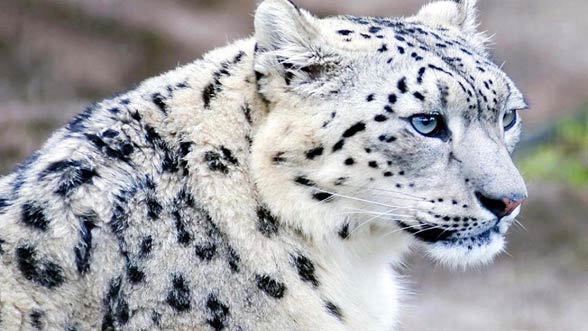
Leopard or tiger?
Although the cat is given a name of a leopard, it has more in common with the tiger, than with the leopard. It is because both species had the same ancestor. However, about 2 million years ago nature decided to separate the species…
Until recently, the snow leopard was classified as a separate genus of cats, Uncia. Since 2006, following a thorough genetic analysis of these cats, a new classification has been established, and now the snow leopard is classified as part of the genus Panthera.
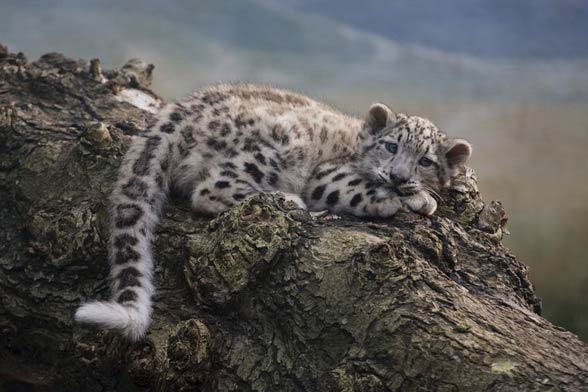
Occurrence – in the footsteps of the Yeti
The snow leopard is a quite mysterious cat, so it’s not surprising that it’s a neighbor of another mysterious creature – the Yeti. It is because it lives in the Himalayas, the Tibetan Plateau, and in Central Asia. In the summer, it occurs at altitudes from 3,350 to 6,700 m (11,000 – 22,000 ft). Sometimes it is seen by Himalayan mountaineers.
The cat also inhabits both forests and grasslands, and mountainous areas. In the winter, the snow leopard comes down to lower areas from 1,200 to 2,000 m (3,940 – 6,560 ft).
Snow leopards are among the least known cats. This is due to the inaccessible areas in which these animals occur and their large home range size.

Lifestyle
Snow leopards, like the majority of big cats (except the lion), are solitary. They match in pairs only in the mating season. They are mostly active at dusk and dawn. In order to find food, they cross their hunting territories, following the same paths.
The snow leopard is able to walk even in deep snow (to 85 cm (2ft 9in) depth), however, it usually follows the tracks of other animals (for its own convenience :)).
The snow leopard preys in areas selected by itself, although in the case of meeting another individual, it doesn’t defend its territory very fiercely. The snow leopard’s hunting territory – depending on the topography – varies from 12 to 40 km2 (4.6 – 15 mi²).
The snow leopard is able to cross over 40 kilometers (25 miles) overnight.
Snow leopard – the greatest cat-leaper
The snow leopard can leap for a distance of 15 meters (49ft 3in)! In this competition it is unrivaled. Even the cougar, which leaps for a distance of 12 meters (39ft 4in), couldn’t win over the snow leopard in this competition.
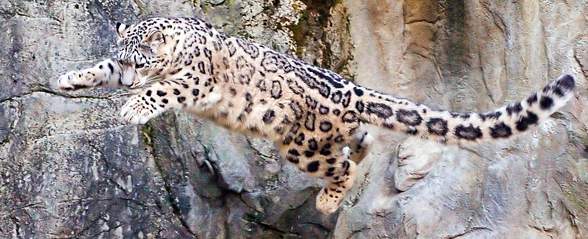
Characteristics
Appearance
The snow leopard’s fur is thick, greyish on the back and white or creamy-white on the stomach. Some cats’ fur is slightly brownish. Moreover, there are black or dark brown spots on the fur. The coloration of the snow leopard gives it great camouflage. Thick fur and an incredibly long tail – up to 100 cm (3ft 3.4in) in length – are the distinctive features of the cat.

Snow leopard prey
The snow leopard preys on ungulates, for example, goats. They also feed on boars, musk deer, marmots, birds and small vertebrates. When the snow leopard is hungry, it can sneak up on households in search of food. Then, domestic livestock, such as poultry and cattle, become its prey.
The only animal that is beyond the reach of the snow leopard is the yak (Bos grunniens), which, because of its size, has no natural enemies.
The diet of snow leopards sometimes consists of plants – tiny twigs and grass.
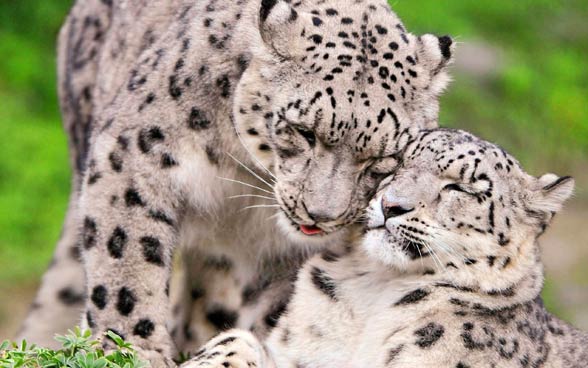
Population
The population of the snow leopard is small. In 1994 it was estimated at between 4,000 and 6,500 individuals. Nowadays, it is believed that there are no more than 2,000 – 3,000 cats. In zoos there are around 600 snow leopards. In Europe you can find snow leopards for example in Poland. You can see them in several zoos – in Gdańsk, Cracow, Łódź, Opole, Płock, Poznań and Warsaw.
Occurrence/Population
- Afghanistan: 100-200
- Bhutan: 100-200
- China: 2,000-2,500
- India: 200-600
- Kazakhstan: 180-200
- Kyrgyzstan: 150-500
- Mongolia: 500-1,000
- Nepal: 300-500
- Pakistan: 200-420
- Tajikistan: 180-220
- Uzbekistan: 20-50
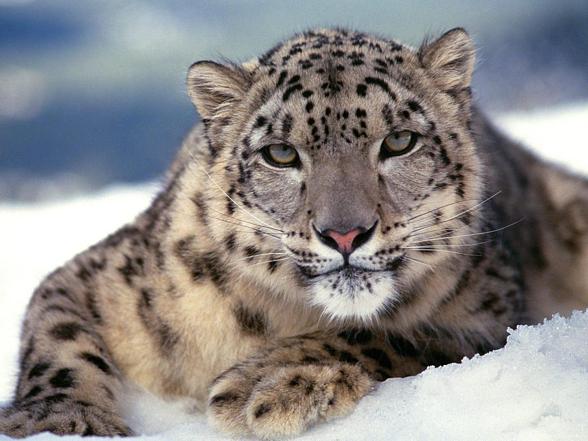
Reproduction
Snow leopards match in pairs only in the mating season. The mother gives birth to 2-5 cubs, that stay with her until they’re one year old. The young snow leopards are born in caves or rock crevices that are bedded with moss and their mother’s hair. The young are darker than their parents, which enables them to blend into their surroundings and hide among rocks.

Conservation
The snow leopard is on the list of the International Union for Conservation of Nature as a protected species. It is also included in the Convention on International Trade and Endangered Species of Wild Fauna and Flora which limits trade in wild animals.
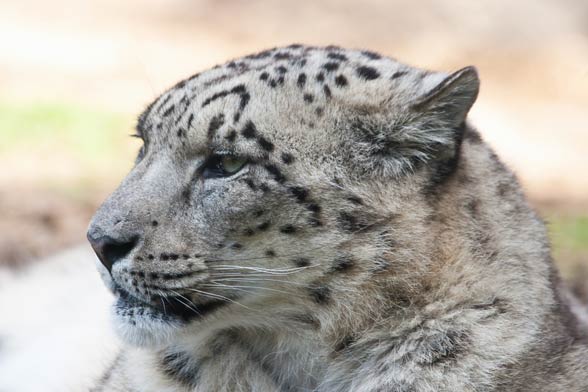
Snow leopard doesn’t roar…
The majority of websites state that snow leopards don’t roar… In fact, the lion is the only big cat that actually roars. Other cats, indeed, make various noises, but they can’t be compared to a lion’s roar. The tiger, for example, growls, and the cougar is the largest cat that… meows. The snow leopard makes similar sounds to those of other big cats, except for the lion. However, we won’t be playing onomatopoeia 🙂 Below, we present a short video from a zoo so you can decide for yourselves what sounds the snow leopard makes.
Details/Dimensions
The snow leopard (Panthera uncia)
- Length without tail: 75 – 130 cm (2ft 5.5in – 4ft 3.2in)
- Tail length: 80 – 100 cm (2ft 7.5in – 3ft 3.4in)
- Height at shoulders: 60 cm (1ft 12in)
- Weight: 27 – 55 kg (59 – 121 lb); rarely 75 kg (165 lb)
- Lifespan: 16 – 18 years

Snow leopard – interesting facts
- The snow leopard leaps for the longest distance among all cats – to 15 meters (49ft 2.6in).
- The long tail is used as… a rudder to keep balance during a leap.
- The snow leopard has short and wide forepaws, which enables the cat to walk through deep snow.
- The hind legs of the snow leopard are longer and they enable the cat to do incredibly long leaps.
- The pads of the snow leopard’s paws are hairy.
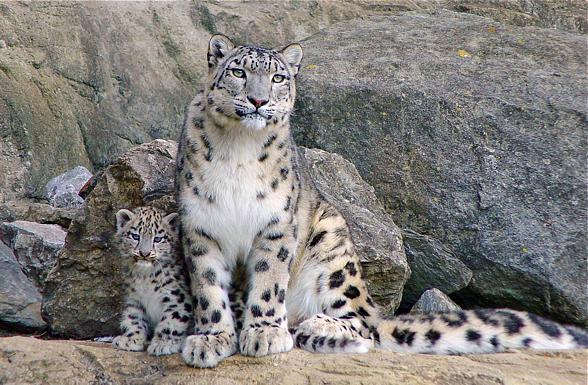

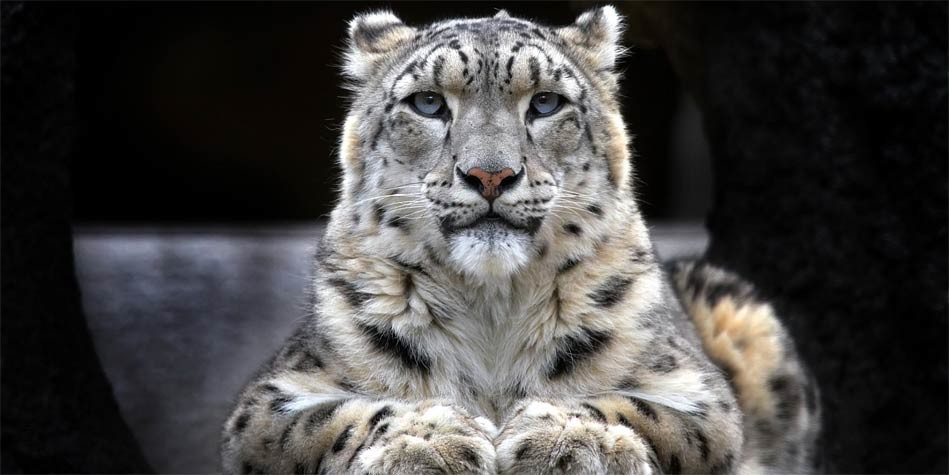
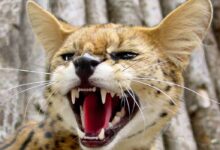
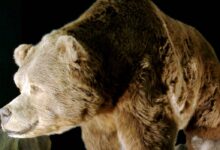






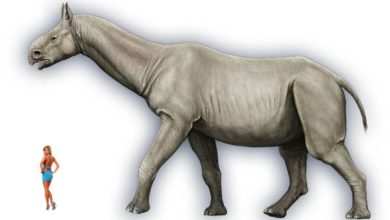
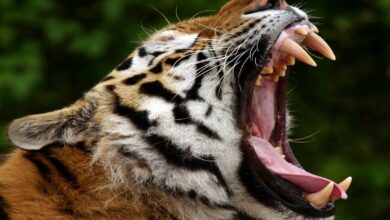


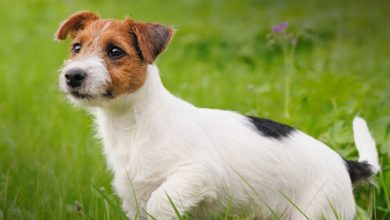
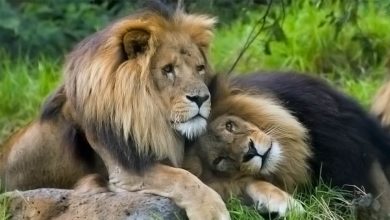

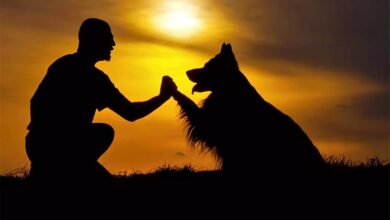

Beautiful, gorgeous wild cat.